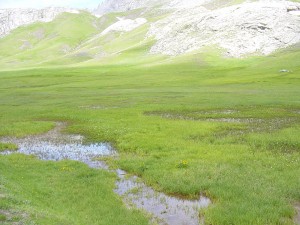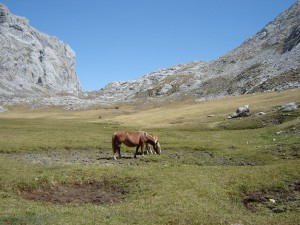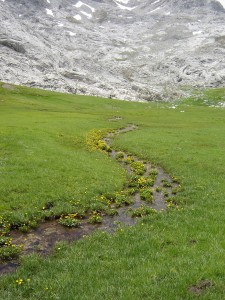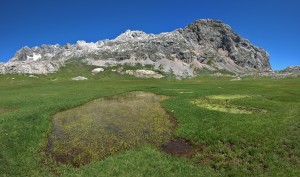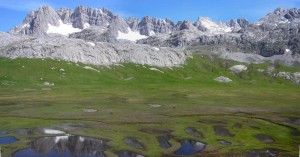Enclave name: Liordes meadow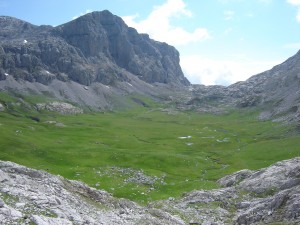
Protection Categories: The enclave is integrated in the SCI and SPA ES0000003 Picos de Europa (Castilla y León), within the Picos de Europa National Park and Biosphere Reserve.
Location: The Liordes meadow is located in the munipal Posada de Valdeón, province of León.
Region: Castilla y León.
Reference coordinate: 30TUN5079
Surface of the wetland: 35 hectares
Altitude: 1.880 metres
The Liordes meadow is a glaciokarstic depression associated with a fault, surrounded by limestone walls that reach heights of 2200-2400 meters. In connection with the fault hydrothermal advancement occurred leading to zinc deposits exploited in the past.
The enclave has a mountain climate, conditioned by its geographical location, in the heart of the Picos de Europa, and its high altitude (1800 m).
The meadow is in the subalpine (thermotype orotemplado) and is crossed by a small stream, only active in the central massif of the Picos de Europa stream channel, allowing the development of herbaceous communities that do not wither in the summer. The bottom of the basin, with smooth edges and flat in the central area, is carpeted with an extensive Cervunal, dotted with patches of flat peatlands developed around the trails. These grasses and wetlands starkly contrast with the vertical limestone walls that surround them, in which communities of cracks and ledges and scrub develop dominated by endemic gorse Genista Legionensis.
- MORE RELEVANT FEATURES
Singularity
In Liordes the largest system of flat eutrophic peatlands of the LIC, Picos de Europe National Park and Biosphere Reserve is concentrated, and it includes one of the two known populations of Salix hastatella subsp. picoeuropeana, endemic taxon of this mountain range.Biologic and Ecologic Features
The aspect that stands out most is the set of hygrophilous and peat formations that develop around the small stream that runs along the bottom of the karst depression and areas of upwelling water. They are flat peatlands in whose composition several sedges are involved (Carex sp.pl.) and rushes (Juncus sp.pl.), and in which several endemic species are present, in addition to small ponds with aquatic vegetation dominated by Callitriche palustris.Geomorphological Features
The geological substrate of depression Liordes consists entirely of rocks of carboniferous age: limestones of the Picos de Europa, representing the rocky masses that surround the basin, and a formation of shale, limestone and sandstone called The Lebeña Formation, that appear in the central area of the enclave. On the Northern edge of the basin a fualt runs in the WNW-ESE dirction, the Liordes fault, which seems to be responsible for the elevation of the limestone and the development of the basin. The filling of the depression is varied with clay shale deposits on the central region, while the margins are recognized glacial deposits, torrential and different slope deposits. These deposits are a testament to the mixed origin of the basin, a result of tectonic, glacial and karst processes.Historic and Paleo-ecological Features
Of glaciokárstico origin, Liordes is a polje caused by the overriding contact between the limestone and the Lebeña Formation materials. The basin caused is filled with decalcification clays, generating red clay soils on calcareous soils and debris (regosols) bordering depression. Regarding the hydrological conditions, of the the Liordes meadow can be defined as a fen or peatland which is fed primarily by groundwater from numerous sources arising from the limestone in contact with the fault. The waters are concentrated in two small streams that join a ponor located in the SW part. This leads to almost all soil materials being under a regimen of hydric soils, which means that the water level is between 0 and 30 cm during the growth period of the plants in almost all of the basin.Habitats of Community Interest
Código Natura 2000 Denominación Prioritario 3260 Ríos de pisos de planicie a montano con vegetación de Ranunculion fluitantis y de Callitricho-Batrachion 4090 Brezales oromediterráneos endémicos con aulagas 6210 Prados secos seminaturales y facies de matorral sobre sustratos calcáreos (Festuco-Brometalia) *(Importantes sitios de orquídeas) 6230 Formaciones herbosas con Nardus, con numerosas especies, sobre sustratos silíceos de zonas montañosas *
7230 Turberas bajas alcalinas 8130 Desprendimientos mediterráneos occidentales y termófilos 8210 Laderas rocosas calcáreas con vegetación casmofítica Habitats According to Other Classifications: Phytosociological or Others
Código Natura 2000 Código INH1 Sintaxón 3260 226010 Ranunculion fluitantis 4090 309053 Lithodoro diffusae-Genistetum legionensis 6210 521227 Brachypodio rupestris-Seselietum cantabrici 6230 514021 Polygalo edmundii-Nardetum 6230 51604B Luzulo carpetanae-Pedicularietum sylvaticae 7230 623016 Pinguiculo grandiflorae-Caricetum lepidocarpae 8130 721190 Saxifragion trifurcato-canaliculatae 8210 713080 Gymnocarpion robertiani 8210 7130B0 Linarion filicaulis Flora
The higrófilos Liordes habitats feature a large cast of interesting flora. So, located here are creeping willow Salix hastatella subsp. picoeuropeana, endemism of the Picos de Europa, Juncus balticus subsp. cantabricus, Cantabrian endemic, and Pedicularis mixta, Pyrenean-Cantabrian endemic. In addition, there are representations of species listed at regional and national levels, such as Potentilla fruticosa, Callitriche palustris, Equisetum variegatum, Swertia perennis or Astragalus danicus.Fauna
The Liordes meadow is at a high altitude, above 1800 meters, which may explain their lower faunal diversity. The invertebrate community is not well known and among the vertebrates only three species of amphibians are found: Alpine newt (Mesotriton alpestris), the common toad (Alytes obstetricans) and the grass frog (Rana temporaria). The most abundant mammal that the wetland can reach is the chamois (Rupicapra pyrenaica).- PHOTOS



